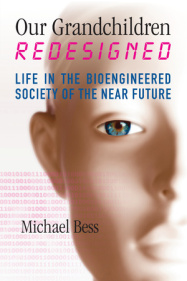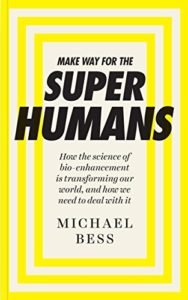Our Grandchildren Redesigned: Life in a Bioengineered Society
Purchase on Amazon | Beacon Press | Parnassus Books
(UK Edition: Make Way for the Superhumans
This is a book about the near and middle-term future – a time horizon that extends from the present day through the middle decades of the 21st century. It assesses the impact that biotechnologies will have on our lives, as they come to be applied with increasing pervasiveness to the modification of human bodies and minds. Through the use of pharmaceuticals, we are learning how to control our moods, boost our physical and mental performance, increase our longevity and vitality. Through the application of prostheses, brain implants, and other bioelectronic devices, we are not only healing the blind and the paralyzed, but beginning to reconfigure our bodies, augment our memories, and generate entirely new ways of interacting with machines. Through genetic interventions, we are not only neutralizing certain diseases long thought incurable, but opening up the very real possibility of taking evolution into our own hands – redesigning the human “platform” of body and mind in a thoroughgoing way.
Some of the benefits that flow from these bioenhancement technologies will be spectacular in nature, offering wonderful new capabilities and powers. At the same time, some of their drawbacks and dangers will be so profound that they will justify the banning of particular categories of enhancement interventions or devices. All these technologies – even the most apparently sensible and benign ones – will destabilize key aspects of our social order, as well as our understanding of what it means to be human. I argue that contemporary society is dangerously unprepared for the dramatic changes it is about to experience, down this road on which it is already advancing at an accelerating pace.
Among the topics explored in the book:
– Strategies for envisioning the middle-term future. By taking into account the distinctly layered time-frames of historical change, we can increase our effectiveness in describing “possible futures.”
– The science and technology of human bioenhancement: eight key areas of innovation. Pharmaceuticals, bioelectronics, genetics, nanotechnology, robotics, artificial intelligence (AI), synthetic biology, and virtual reality.
– The fierce debates between advocates and opponents of transhumanism and “the posthuman future:” how to find a critical, constructive way forward.
– Human flourishing: a moral framework for evaluating specific bioenhancements on a case-by-case basis.
– The revolutionary potential of epigenetic enhancement modifications.
– If bioenhancements are adopted by millions of consumers, what would be the likely economic, social, and cultural consequences?
– Bioenhancement of animals: should we create new hybrids and augmented creatures?
– Direct modifications of brain and mind: how the new field of neuroethics can help us clarify and evaluate the implications.
– The tantalizing (and problematic) possibility of “moral bioenhancement.”
– The commodification of humans, and the specific ways in which bioenhancement technologies could erode human dignity.
– Rejuvenation technologies and extremely long healthspans – what would be their ecological, economic, and psychological consequences?
– The Singularity, radical bioenhancement, and the possibility of creating human-level forms of artificial intelligence.
– Values worth preserving as the enhancement enterprise goes forward over the coming decades.
– The space for human agency in steering the development of scientific and technological innovation.
Read Reviews and Recent Press
Appendices:
- Appendix A: Debates Over the Definition of “Enhancement”
- Appendix B: The Functional Architecture of the Human Brain
- Appendix C: Strategies for Radically Increasing the Human Healthspan
- Appendix D: Debates Over Genetic Engineering of Plants and Animals
- Appendix E: Artificial Chromosomes and Flexible Germline Engineering
- Appendix F: Rationale for List of Ten “Flourishing Factors” in Chapter 6
- Appendix G: The Concept of Human Dignity
- Appendix H: Prerequisites for Meaningful Moral Action
- Appendix I: Scholarly Literature on Human Nature and Personhood
- Appendix J: The Boundary Between Human Persons and Animals
- Appendix K: The Implausibility of Transmigrating Human Consciousness into a Machine Body
- Appendix L: Ray Kurzweil and the Singularity
- Appendix M: Gene Therapy Techniques
- Appendix O: Germline Engineering and Human Autonomy
- Appendix P: Why We Should Defer the Creation of Autonomous, Human-Level Forms of AI
- Appendix Q: Benefits and Dangers of Human Bioenhancement: A Balance-Sheet

